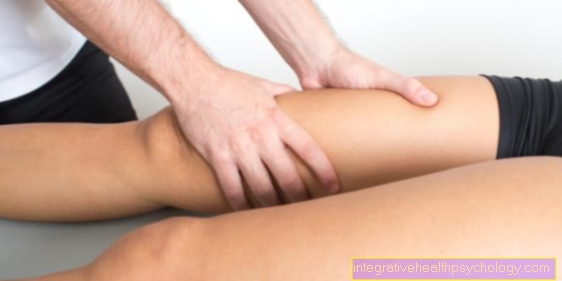Cracked cuticles
introduction
The skin that lies directly on the nail and covers the invisible part of the nail is called the nail fold. This is also called nail wall, nail fold or technical language Perionychium or. Paronychium called.
The nail fold protects the regrowed nail plate until it is really firm and becomes visible. If this cuticle is torn, painful inflammation in the area of the nail can occur. There are various reasons for this, but also treatment and prevention through proper nail care.
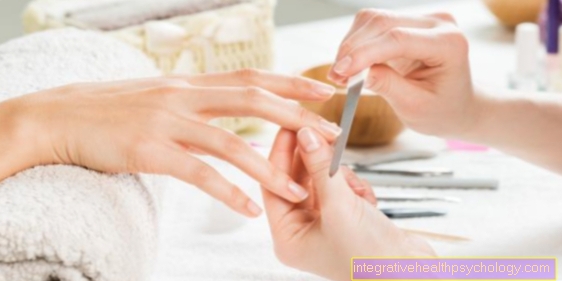
causes
There are a number of causes that can cause cuticles to tear. Cracks in the cuticle are not only a cosmetic problem. The cracked cuticle can sometimes be very uncomfortable to painful. In addition, cracks in the cuticle make it easier for germs and dirt to enter and thus represent a risk factor for the development of inflammation.
The following article looks at the various causes, symptoms and possible therapeutic approaches for cracked cuticles. It also answers the question of how best to take care of your cuticles yourself in order to avoid cracks. The most common causes are listed below:
- Chewing the cuticle
- No or wrong nail care
- Vitamin deficiency
- Other less common causes
Chewing the cuticle
Under one Perionychophagia means the chewing of the skin that surrounds the nail. A distinction is also made between Perionychophagia and Perionychomania. The Perionychomania is like nibbling on the cuticle, but not completely bitten through. Both forms of chewing are not independent clinical pictures, but rather have to be viewed as symptoms. They are mostly an expression of stress, inner restlessness, mental illness and are to be viewed as self-harming, auto-aggressive or self-calming behavior for those affected. Perionychophagy usually involves nail biting (Onychophagia) hand in hand.
Constant chewing on the cuticle causes it to become cracked, brittle or sometimes bloody and sore. This favors the development of concomitant diseases such as warts, chronic nail bed irritation, inflammation and nail growth disorders.
Read more about this under Chewed fingernails
No or wrong nail care
Proper nail care is more important than many people attach to it. The cosmetic advantages are rather in the background. Incorrect or missing nail care can lead to the symptom of torn cuticles and their inflammation. This is the most common cause of cracked cuticles. If the cuticle is not cared for regularly, it will stick to the nail and will be pulled along with its growth and begin to tear. Incorrect nail care, such as cutting back the cuticle, also promotes inflammation and cracks.
Ideally and for prevention, which will be explained in more detail later, the cuticle should be pushed back slightly with the blunt tip of a nail file at the transition between the skin and the nail, for example after a shower, and thus loosened from the nail. Further care tips can be found further down on this page.
Vitamin deficiency
Cracked cuticles can result from a lack of vitamins.
In particular, vitamin B or vitamin D deficiencies, but also insufficient intake and activation of calcium and iron, can lead to cracked cuticles.
The deficiency symptoms often result from malnutrition.
Since most of the vitamins of the B family - with the exception of vitamin B12 - cannot be stored by our body, they must be ingested daily through food.
A vitamin B deficiency can develop, for example, as a result of a vegetarian or vegan diet. A distinction is made between various vitamins in the vitamin B group, all of which are essential for the energy metabolism.
The cells of the cuticle are also dependent on sufficient vitamin B. The vitamins of the B family influence each other, work together and complement each other. However, there are typical tasks of the individual vitamins in this group.
Vitamin B 7 in particular plays an important role in relation to (nail) skin functions and nail diseases. Vitamin B 7 is also known as biotin.
Among other things, it supports the physiological cell growth of the cuticle cells. Diets, regular alcohol consumption and pregnancy can lead to a deficiency that can manifest itself in cracked cuticles.
But vitamin B 2 also plays an important role in maintaining an intact cuticle. For example, it supports the formation and growth of cuticle tissue. Chronic inflammation, genetic factors, high alcohol consumption, cancer and disorders of the gastrointestinal tract can cause a vitamin B 2 deficiency.
But growth phases can also temporarily lead to cracked cuticles - due to an increased vitamin B 2 requirement.
In addition, vitamin B 5 plays a role in the regeneration of injured, cracked cuticles. Alcohol and coffee consumption as well as diets can lead to a deficiency in vitamin B 5. A vitamin B deficiency often goes undetected. If this is expressed, it is often unspecific.
Loss of energy, tiredness, susceptibility to infection, reduced physical and psychological resilience, reduced cognitive performance, impaired concentration and weakness can result. If these complaints occur separately or in connection with cracked cuticles, one should look for the possible cause.
If a vitamin B deficiency persists over a long period of time, irreversible long-term effects can be the consequence. If the deficiency is discovered early enough, however, it can be compensated for. However, it is not always that easy to detect a vitamin B deficiency.
The reason for this is that the symptoms are not always clearly evident. In addition, normal values are sometimes measured in the blood - even if there is already a deficiency, for example in the body cells of the cuticle.
In addition, it is possible that sufficient vitamins are absorbed, but that there is a deficiency due to a disturbance in utilization. In addition, the use of certain medications and stress can cause a vitamin deficiency and thus cracked cuticles.
For example, certain antibiotics can bind calcium. This means that the calcium no longer reaches the parts of the body where it is needed. This can, among other things, lead to cracked cuticles.
Vitamin D is also required to activate calcium. Vitamin D, in turn, is dependent on vitamin K. If the cracked cuticle is caused by a vitamin deficiency, it is usually not sufficient to focus and substitute just one vitamin.
In order to adequately remedy a vitamin deficiency, it is important to have the values measured by a doctor. In some cases, a change in diet and lifestyle can restore sufficient nutrients to the body. In other cases, individual dietary supplements are required.
In order for the measures to be successful, medical advice is recommended.
Please also read the articles: Malnutrition such as Vegan Diet for Children - Harmful or Safe?
Other causes
The cuticle can also be cracked and brittle due to other diseases or deficiencies. For example, patients with psoriasis (psoriasis) sometimes also have changes in their nails and cuticles. A fungal attack on the nail can also damage the surrounding cuticle. The result is rough, cracked skin. People with malnutrition (anorexia, bulimia, etc.) also often suffer from brittle nails and cracked cuticles.
Apart from taking care of the skin, combating the causes is very important here. Patients with psoriasis have mostly been involved in various therapeutic approaches (medicinal, psychotherapeutic, etc.) for a long time. A fungal attack on the nails is causally treated with antimycotics. Therapy for people with eating disorders includes from psychotherapeutic approaches to normalize eating behavior.
Inflammation of the cuticle
Under one Paronychia one understands the inflammation of the surrounding cuticle (nail fold). Paronychia can result from small trauma and cracks in the cuticle through which pathogens can enter. There are several pathogens that can cause paronychia, the most common of which is staphylococci. But the Candida fungus or a primary infection with syphilis can also result in a Paronychia express.
Nail biting, finger sucking and an excessive manicure and pedicure can damage the cuticles and lead to the entry of the pathogen.
Paronychia is characterized by cracked cuticles, swelling and reddening. It is also tender on pressure. If the infection spreads to surrounding structures such as the nail and nail bed, changes will also appear here.
Cracked cuticles in children
Cracked cuticles can develop in children for the same reasons as in adults.
In addition, there may be an increased requirement for vitamin B 2 in certain growth phases of childhood and puberty.
In addition, the cracked cuticle can develop or worsen in children if the cuticle is nibbled or nibbled in stressful situations. Depending on their age, children may find it harder to understand why they should not do this. This makes it easier for bacteria to penetrate. As a result, bacterial inflammation can occur.
Treatment for cracked cuticles in children depends on the cause. This should be found out with the help of a pediatrician. If there is a vitamin deficiency, these must be substituted individually.
If a care problem is the cause, gentle care products or home remedies suitable for children can be used. In order for the children to take part in these care measures on a regular basis, the parents need a little creativity. It is helpful to carry out these measures at fixed times and as part of a game or story. The more fun the children have with the care rituals, the easier it is for them to keep them regularly.
If the cracked cuticle arises due to mental problems or reduced psychological resilience, it is essential to find out the cause. The child should be given enough space and time and someone they trust should be provided so that they can deal with certain events or situations.
Read more on this topic at: Symptoms of stress
therapy
The therapy of perionychophagia or onychophagia should be directed against the causes and less against the symptoms. Attempts should be made to treat psychological pressure, stress, anxiety or previous mental illness. Autogenic training and relaxation techniques can help those affected to control their behavior and thus stop chewing. Since perionychophagia often develops in early childhood (from around 4 years of age), play therapy is used here. Behavioral therapies can be used in older children and adults.
If inflammation has already developed, antiseptic sprays and ointments can be used. In addition, the cracked skin can be cared for with plasters and bandages as well as soothing creams. You can also try to keep those affected from chewing with bitter nail polishes from the pharmacy. However, this method does not show success for everyone.
The therapy of paronychia is very simple with uncomplicated courses. Usually an ointment bandage and immobilization of the affected finger or toe are sufficient. If the infection has spread deeper, an incision (incision) with drainage of the pus may be necessary.
Home remedies for cracked cuticles
It is important to find the cause of the cracked cuticle. Accordingly, lifestyle modifications and, if necessary, underlying diseases should be corrected. In some cases, the use of home remedies is sufficient or helpful.
A home remedy of choice is olive oil. The oil should be rubbed liberally on the affected areas.
Then the hands should be wrapped in warm, damp cloths. The exposure time should be between 15-30 minutes.
It is also possible to let the oil work overnight. Instead of the cloths, you can use cotton gloves. Usually the cuticle is less cracked afterwards. This home remedy can be used regularly as needed.
In some cases the addition of sugar is also helpful. A ratio of approximately 1: 1 should be achieved here. An individual adjustment of the quantity ratio is conceivable. The more sugar is added, the greater the peeling effect. Depending on the condition of the cuticle, this effect may or may not be desired.
In other cases, adding lemon juice is preferred. This has a disinfecting effect and thus kills certain pathogens on the cuticle.
In addition, almond or tea tree oil can counteract cracked cuticles. Tea tree oil is, to some extent, considered a type of natural antibiotic.It kills some bacterial and viral pathogens that are found on the cuticle. After the oil treatments, the cuticles should be rubbed with a moisturizing hand cream.
Proper cuticle care
There are a number of different ointments and creams that can be purchased for the care of the hands and cuticles in drug stores and without a prescription in pharmacies. What they have in common is that they are moisturizing and contain soothing extracts such as chamomile or almond oil. There are also ointments with antiseptic components that keep the skin “clean” and thus prevent inflammation and infections. These products can be tried out if necessary and it is best to seek advice from a pharmacy. Apart from that, there are also some home remedies that can effectively help against cracked and brittle cuticles.
However, these self-experiments should be refrained from if pronounced purulent inflammation has already formed or if there is very severe pain.
Nourishing oils
High-quality oils are very suitable for caring for rough and cracked cuticles. A very good combination is almond oil with a few drops of tea tree oil. The almond oil quickly shows good results and effectively cares for the skin. A few drops of tea tree oil have a slightly antiseptic and soothing effect on the sore cuticle. You can apply the oils directly to the cuticle and massage in gently.
If the direct application of the oil is found to be uncomfortable, you can also add a little cream or petroleum jelly to the oils. The creams should be as free from perfumes and fragrances as possible, as these can irritate the skin. Care is more effective if you leave it on overnight. To do this, apply the oil or the cream / oil mixture thickly on the affected areas and cover your hands with cotton gloves while sleeping. In the morning, simply wash off the excess cream residue with a little lukewarm water.
Remove cuticles properly
Excess cuticles should never be cut off just like that. This only favors the development of inflammation. Also protruding cuticle fragments, as they are often with cracked cuticles, should not be cut off and especially not bite off. Chewing the cuticle only leads to the entry of bacteria. If the excess cuticle bothers you, you should soak the cuticle a little in warm water and oil and then carefully push it back.
The hand washing
People with cracked cuticles should be careful not to wash their hands with dish soap or other harsh soaps. In addition, rough paper towels, such as those found in public toilets, and air dryers should be avoided. They only dry out the skin even more and make it more cracked. You should get into the habit of putting lotion on your hands after washing your hands.

.jpg)

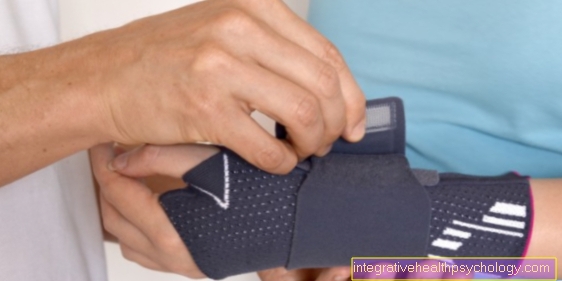




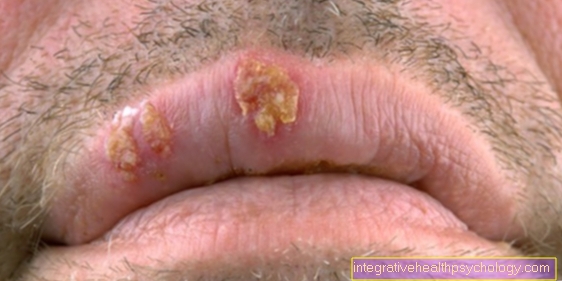



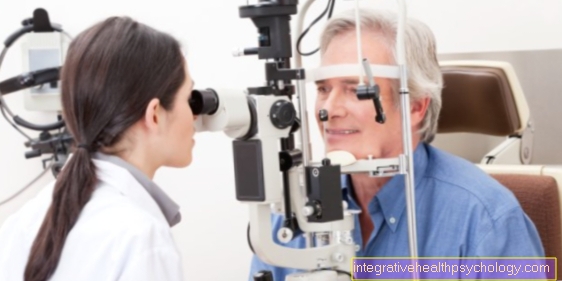



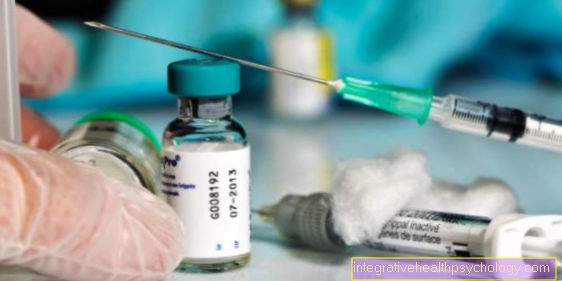
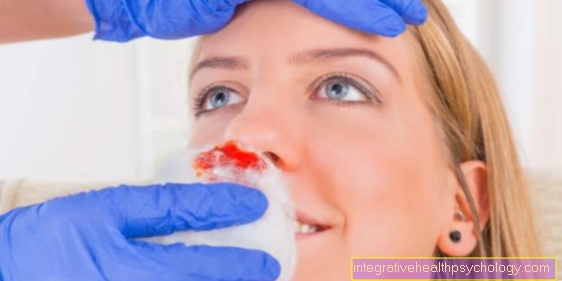
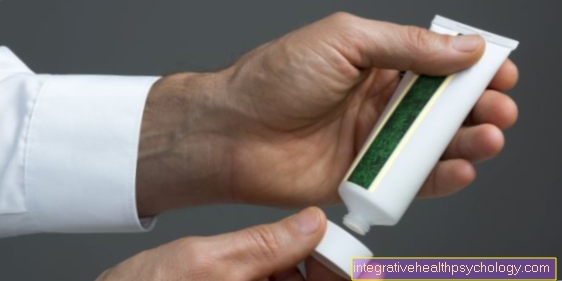



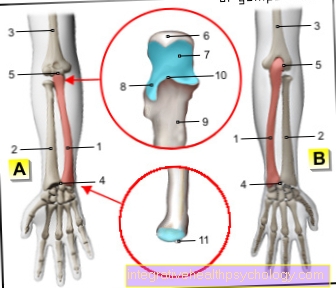
.jpg)

